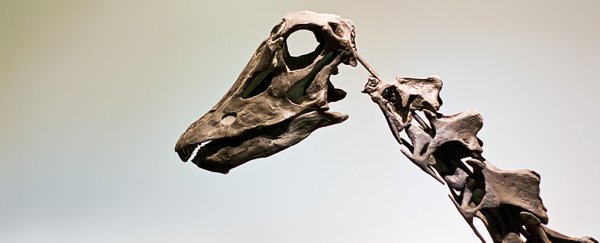After ruling the planet for more than 170 million years, non-avian dinosaurs were suddenly demoted from existence by the impact of a large asteroid that struck the Yucatán peninsula some 66 million years ago.
The collision set off a cascade of environmental devastation, with debris in the atmosphere cutting off life-giving sunlight. Earth's surface temperatures plunged. Animals perished.
Well, that's what most paleontologists think happened.
While evidence for this end-Cretaceous impact is indisputable, debate within the paleontological community has been ongoing as to whether dinosaur extinction was abrupt or gradual.
The extinctions do coincide with a period of long-term environmental upheaval, largely the result of the continued breaking up of the supercontinents Laurasia and Gondwana. High sea levels, cooling climates, the spread of new habitat on land, as well as massive volcanic activity, may have all played significant roles in the mass extinction event.
Up until now, analysis of fossil data has yielded no convincing evidence of a decline in dinosaur species before their extinction. A phylogenetic study in 2016, which used dinosaur timetrees, challenged the idea of a sudden extinction, but this conclusion proved to be contentious.
The fossil record is a notoriously difficult source of evidence, with critiques of that study pointing to gaps in the dinosaur fossil record and sampling biases which could have led to the under-reporting of certain Cretaceous dinosaur species.
Now, a new study has lent additional evidence to the hypothesis that non-avian dinosaurs were already teetering on the edge of extinction before the cataclysmic events of the infamous asteroid impact.
Led by French National Center for Scientific Research phylogeneticist Fabien Condamine, the authors of the new study claim that methodological developments in data analysis have allowed them to take into account certain biases in fossil data, along with uncertainties around the ages of fossils.
The team analysed 1,600 dinosaur fossils to assess the speciation and extinction rates of six major dinosaur families: Ankylosauridae, Ceratopsidae, Hadrosauridae, Dromaeosauridae, Troodontidae, and Tyrannosauridae.
The team found that the diversity of non-avian dinosaurs started to decline approximately 76 million years ago - that's 10 million years prior to the Yucatán impact. They suggest the decline is linked to increased extinction rates in older species, who may have lacked evolutionary novelty and were unable to adapt to changing environmental conditions.
"These results imply that warm periods favored dinosaur diversification whereas cooler periods led to enhanced extinctions," state the authors.
Ecological and physical factors point to a cooling climate as a catalyst for the decline of dinosaur species in the late Cretaceous. These cooling temperatures likely spelled trouble for large dinosaurs in particular, since they relied on a warm climate to maintain a stable body temperature.
"A physiological explanation for the cooling-driven extinction could be the hypothesis that if sex determination in dinosaurs was temperature dependent, as in crocodiles and turtles, sex switching of embryos could have contributed to diversity loss with a cooling global climate at the end of the Cretaceous," the team added.
The researchers also point to additional factors, such as hadrosaurs outcompeting other herbivores - their teeth show they were able to eat a greater variety of plants than more specialized competitors. With herbivores playing an interconnected role in the food web, their decline may have been detrimental to a number of additional dinosaur species.
In the end, data from the new study suggest that the final extinction of dinosaurs really could not be solely attributed to a massive asteroid impact.
While the study could not point directly to the precise ecological mechanisms which underlay the effects of global cooling on dinosaur speciation and extinction rates, the results support the idea that long-term environmental changes likely made non-avian dinosaurs prone to extinction, even before a giant space rock smashed up their home planet.
The study was published in Nature Communications.
